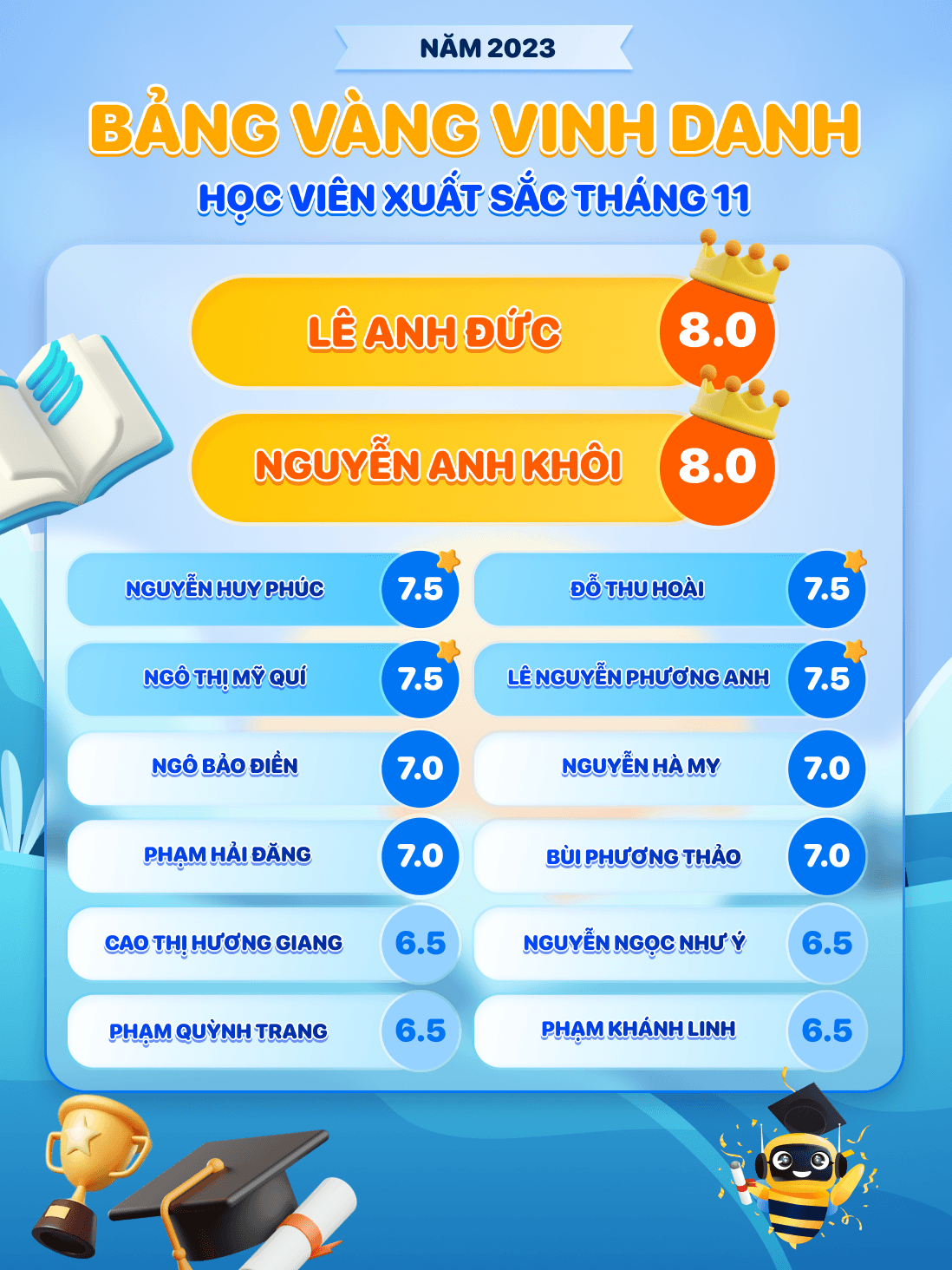Tìm kiếm bài viết học tập
Đề thi, bài mẫu IELTS Writing Task 1 Process/ Diagram khó nhất 2023
Nhắc đến đề thi IELTS Writing Task 1 thì ai cũng muốn "né" ngay dạng bài Process vì "trời ơi nó khó quá mà". Cho dù dạng bài IELTS Writing Task 1 Process là chủ đề rất hiếm gặp trong kì thi IELTS, nhưng một khi đã xuất hiện thì luôn “gây bão” về độ khó. Dạng bài Process có thể không gây trở ngại cho thí sinh bởi phần Coherence và Cohesion gần như đã được "bày sẵn", nhưng lại vô cùng hóc búa bởi độ khó của các từ vựng chuyên môn trong đề thi.
Càng ngày các đề Process IELTS Writing Task 1 lại càng oái oăm hơn do trình độ các thí sinh ngày một nâng cao, ngoài ra nhiều đề còn không có cả mũi tên điều hướng khiến thí sinh “lạc trôi”, không biết "đi đâu về đâu". Vậy nên trong bài viết dưới đây, PREP tổng hợp bài mẫu IELTS Writing Task 1 Process khó nhất năm 2023, hãy cùng tham khảo nhé!
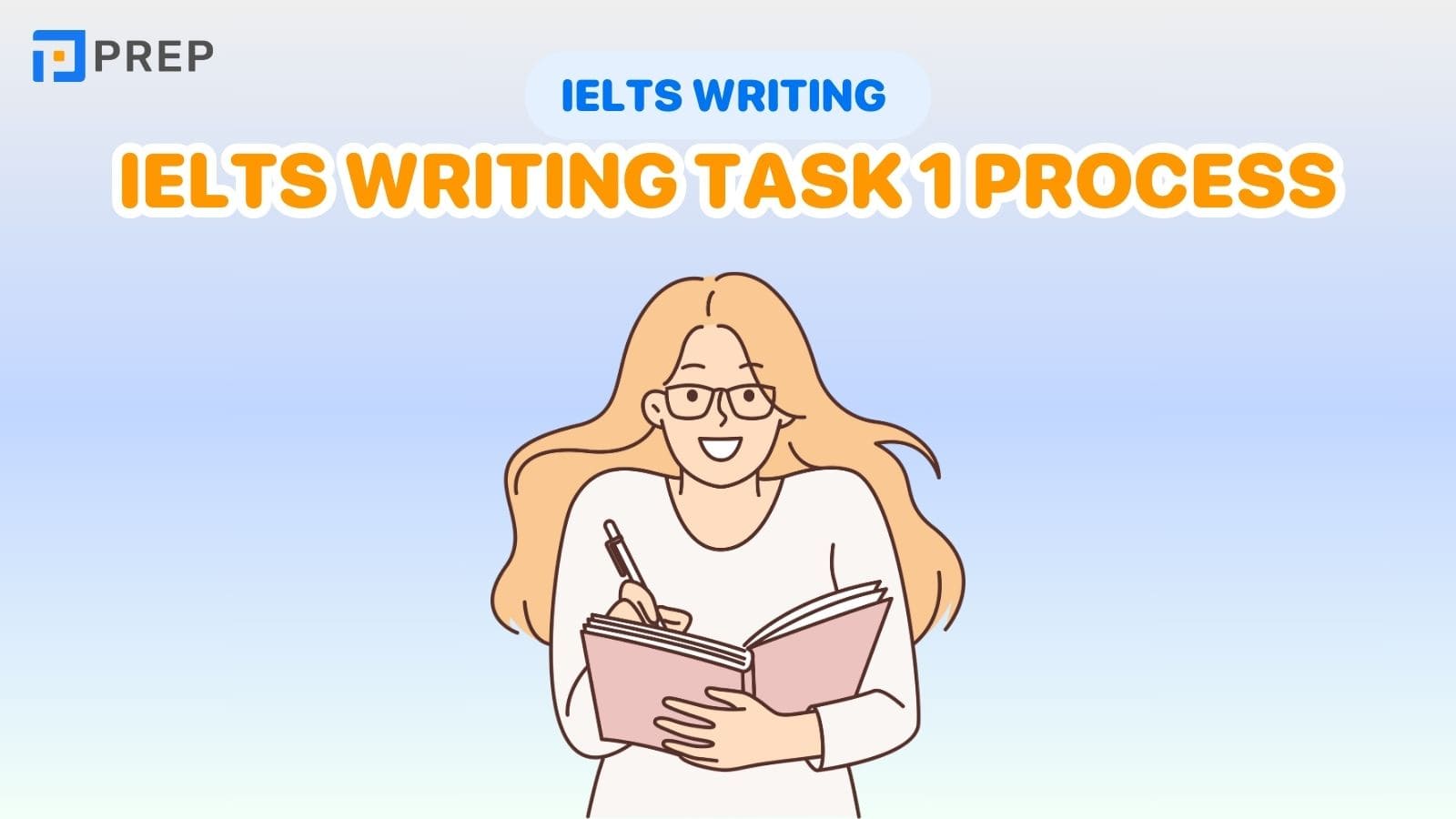
- I. Đề IELTS Writing Task 1 Process và bài mẫu
- 1. Đề bài IELTS Writing Task 1 Process: Miêu tả quá trình tiến hóa của ngựa
- 2. Đề bài IELTS Writing Task 1 Process: Miêu tả sự tiến hoá của công cụ cắt thời đồ đá
- 3. Đề bài IELTS Writing Task 1 Process: Miêu tả quá trình làm nhà tuyết của người Eskimo
- 4. Đề bài IELTS Writing Task 1 Process: Quy trình vận chuyển hàng hóa lên tàu
- 5. Đề bài IELTS Writing Task 1 Process: Miêu tả cấu tạo và cách hoạt động của khinh khí cầu
- 6. Đề bài IELTS Writing Task 1 Process: Coffee Production
- 7. Đề bài IELTS Writing Task 1 Process: Sugar Cane
- 8. Đề bài IELTS Writing Task 1 Process: Neuron thần kinh
- 9. Đề bài IELTS Writing Task 1 Diagram: LED flashlight works
- II. Hướng dẫn luyện đề IELTS Writing Task 1 Process
- III. Lời Kết
I. Đề IELTS Writing Task 1 Process và bài mẫu
1. Đề bài IELTS Writing Task 1 Process: Miêu tả quá trình tiến hóa của ngựa
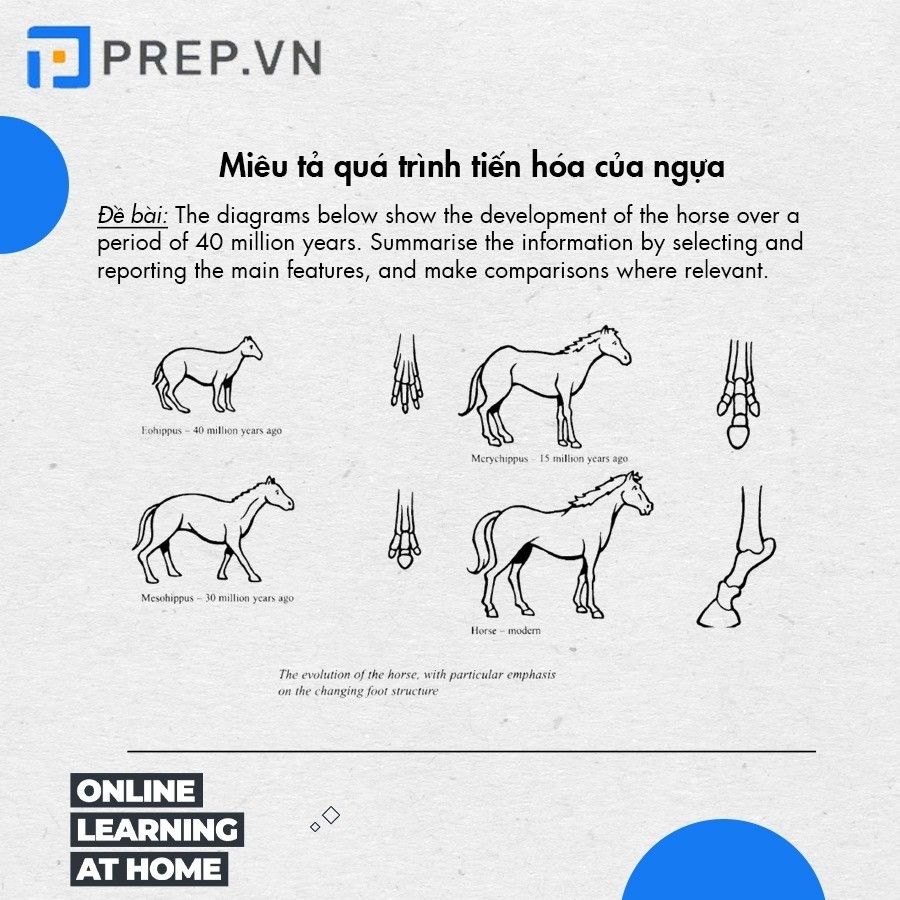
The picture describes the horse's evolution from 40 million years ago until now, focusing on the bone structure of its foot. Overall, as the animal gets more prominent in size and longer limbs, the toes disappear one by one, eventually replaced by a sole hoof.
Eohippus, which existed circa 40 million years ago, was the ancestor of the horse. It was much smaller, standing at about one-fourth the size of a modern horse. All four legs and the tail were relatively short, and, on each paw, there were distinctively four toes. About 10 million years later, the Eohippus became the Mesohippus, which was slightly larger and taller. The foot had lost one toe, and the middle toe had enlarged to create a symmetrical structure. Notably, the Mesohippus had started to develop what would become the horse mane.
At around 15 million years ago, the Merychippus appeared. This pre-historic horse largely resembled the modern horse but at about half the size. The foot still had three toes, but the middle one was greater in size and protruded more to the front. The mane had also become more visible. Finally, the horse today has all the toes reduced just to a single hoof. It is taller, with lengthier limbs, a more defined tail, and a clearer mane on the neck.
Để làm bài Writing Task 1 Process, hiệu quả hơn, bạn có thể tham khảo thêm bài viết:
2. Đề bài IELTS Writing Task 1 Process: Miêu tả sự tiến hoá của công cụ cắt thời đồ đá
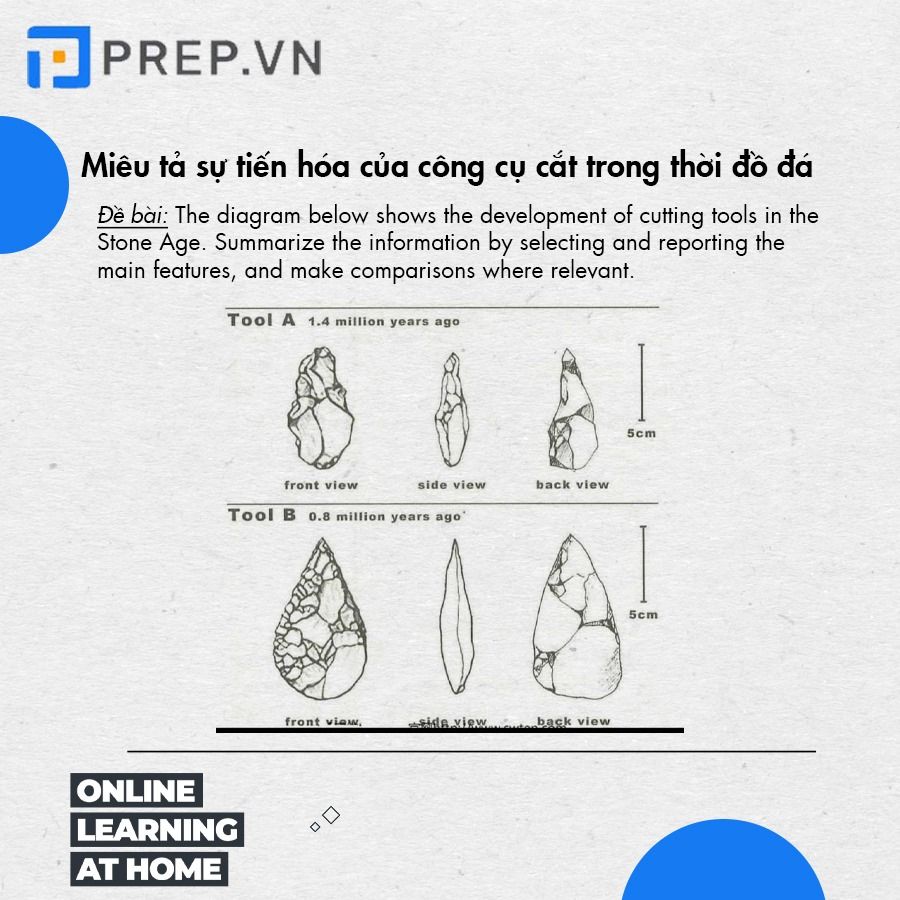
Bài mẫu đề thi IELTS Writing Task 1 Process - sự tiến hóa của công cụ cắt thời đồ đá:
The pictures describe the evolution of Stone Age cutting tools between 1.4 million and 0.8 million years ago. It can be seen that the latter design had seen vast improvements in the size, shape, and finishing quality.
Tool A, which dated back to 1.4 million years ago, was rather small and rudimentary. At about 7cm in length, the tool was thin and did not display much craftsmanship. The front and back views were plain with only some slight chiselling effort while the side was rough and not very indicative of a cutting utensil.
Tool B showed many updated features compared to the older version. First of all, it was larger and sturdier due to a better water drop design with a broad base and a pointy top. Second, both front and back sides were grounded more evenly and smoothly. Finally, although the tool's thickness stayed relatively the same after 0.6 million years, the side edge was undoubtedly much more finely sharpened.
3. Đề bài IELTS Writing Task 1 Process: Miêu tả quá trình làm nhà tuyết của người Eskimo
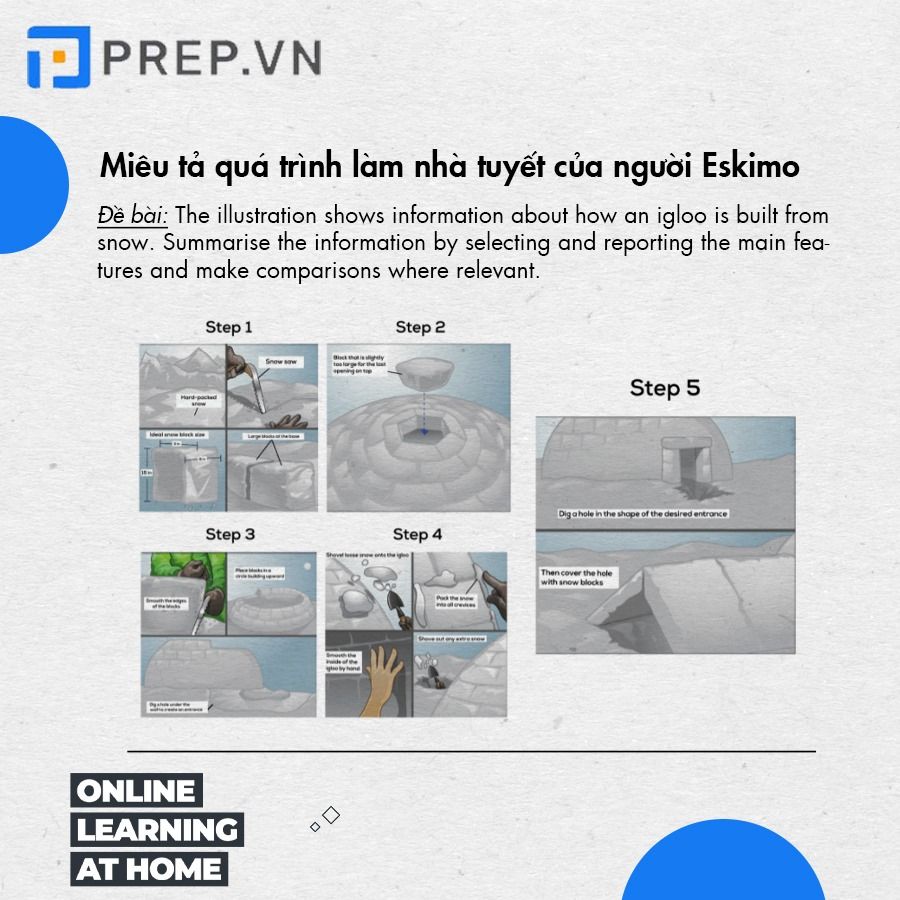
Bài mẫu đề thi IELTS Writing Task 1 Process - quá trình làm nhà tuyết của người Eskimo:
The given diagram illustrates the process of building an igloo, a type of dwelling made by the Inuit people. It can be seen that the igloo is made solely of snow and that at least 10 steps are required to create this sort of shelter.
Initially, only hard-packed snow can be used to make igloos because of its toughness and thickness. After being collected, the snow is sawed into rectangular blocks, of which the largest ones are used to form the base of the igloo. When the base is complete, the next blocks will have their edges smoothed by the builder to be placed on top one another, until a dome-like structure is shaped. Then, a hole is dug under the igloo’s wall in order to make an entrance, while on top of the dome, a significantly large block of snow will be used to cover the final opening. Thus, an igloo is shaped.
In the subsequent steps, softer snow is shoveled upon the igloo to provide further coverage, after which the builder makes sure that this snow is also packed tightly into all crevices between blocks. The inside of the igloo is burnished by hand, and afterward, the shelter’s entrance hole is covered with more snow blocks to prevent exposure to the cold. To conclude the process, small holes will be poked on the dwelling’s wall and roof to allow ventilation.
4. Đề bài IELTS Writing Task 1 Process: Quy trình vận chuyển hàng hóa lên tàu
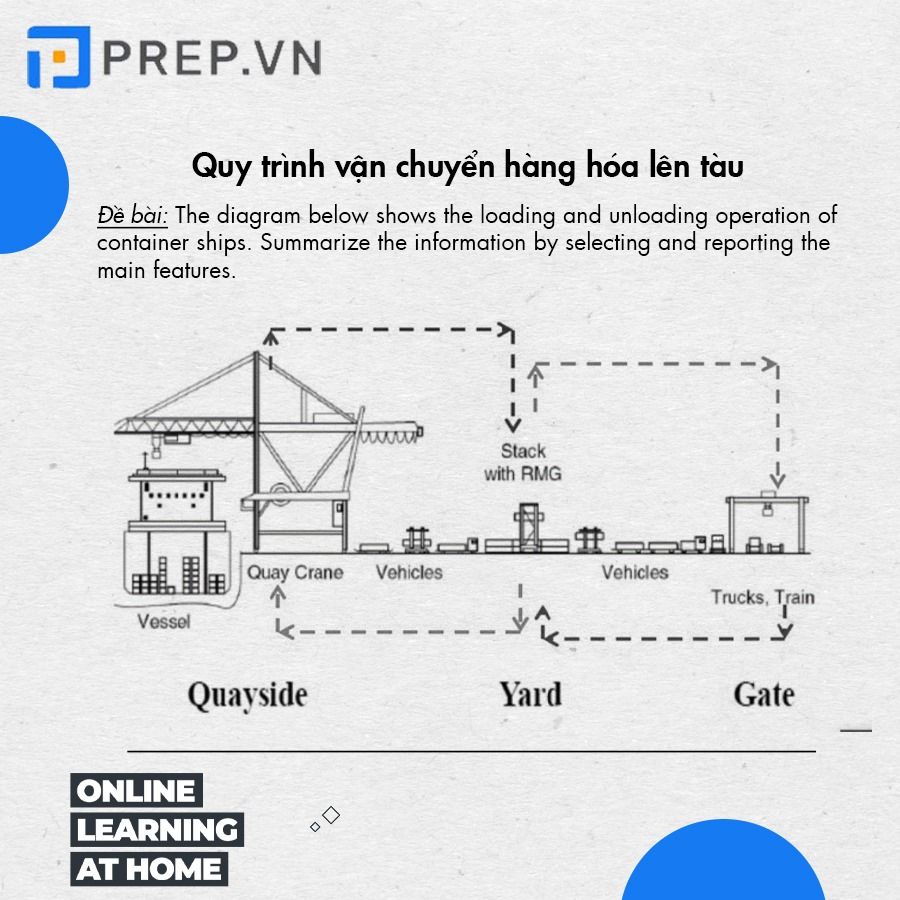
Bài mẫu đề thi IELTS Writing Task 1 Process - Quy trình vận chuyển hàng hóa lên tàu:
The diagram shows how goods are transferred within a harbor. It can be seen that two cranes, namely the quay crane and the RMG crane, play a vital role in handling goods.
Initially, when a freighter docks, a gigantic quay crane is utilized to help the vessel unload cargo. The quay crane does this by picking up items from the vessel’s cargo compartment, followed by moving them back into the land. On land, the cargo is subsequently taken by vehicles to the yard, where it is stacked and arranged by a machine called the RMG crane onto vehicles that take it to the gate. Afterward, the goods are transported either by rail or by road to their next destination.
The process of placing cargo on a freighter works inversely, as goods are first delivered to the harbor’s gate by truck and train, then brought to the yard. There, they are also stacked and arranged by the RMG crane to prepare them for the last loading stage. Finally, at the quayside, freight is loaded by the quay crane onto the vessel.
5. Đề bài IELTS Writing Task 1 Process: Miêu tả cấu tạo và cách hoạt động của khinh khí cầu
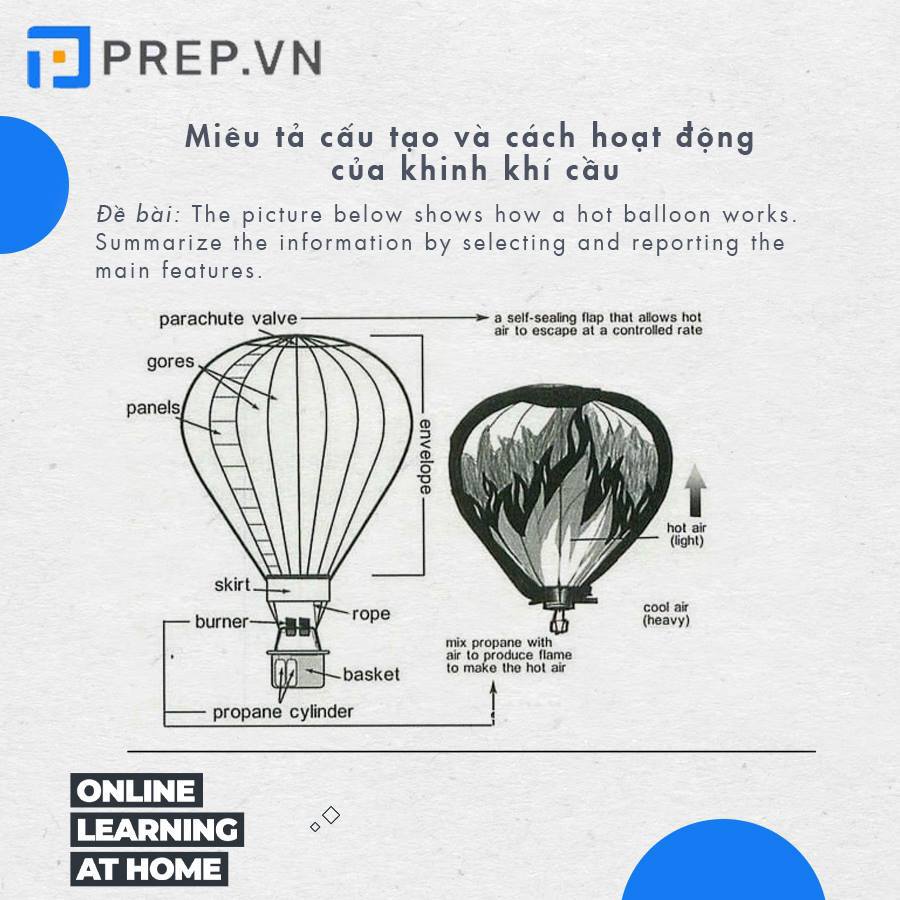
Bài mẫu đề thi IELTS Writing Task 1 Process - Miêu tả cấu tạo và cách hoạt động của khinh khí cầu:
The given diagram depicts the mechanism inside a hot air balloon. It can be inferred that the hot air balloon’s operation is dependent on the principle where hot air rises to the top and cool air flows to the bottom.
The balloon itself is called the “envelope”, formed by sewing together “gores”, which are vertical sections comprising even smaller horizontal panels. On top of the balloon is a flap known as a parachute valve; during the hot air balloon’s flight, the valve controls the escape of excessive hot air and seals itself when hot air needs to be kept in. Meanwhile, the base of the balloon, called the “skirt”, is tied to the basket – the balloon’s passenger space – with several strong ropes. The basket’s most crucial parts are its propane cylinder and burner, responsible for providing the ignition that makes flight possible.
In order to fly, the burner mixes propane from the cylinder with air to produce flame and make hot air. As the air inside the balloon becomes hotter, it will rise to the top due to having a lower density than the cool air.
6. Đề bài IELTS Writing Task 1 Process: Coffee Production
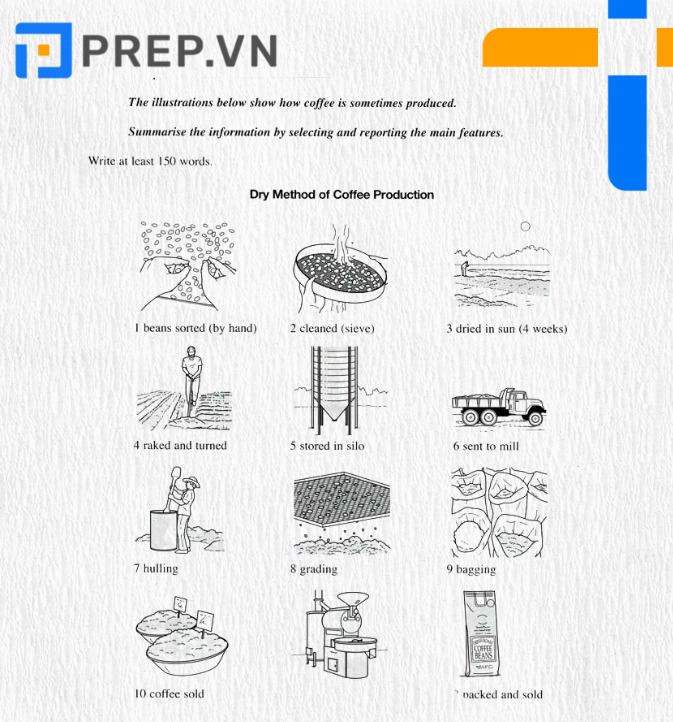
Bài mẫu đề thi IELTS Writing Task 1 Process - Coffee Production:
The flow chart illustrates one method to produce coffee. Overall, there are twelve steps of the process, beginning with the sorting of beans by hand and culminating in packing and selling coffee to the market.
In the initial phase, coffee beans are carefully sorted by hand before being cleaned in the sieving process. These beans are then dehydrated under the heat of the sun for four consecutive weeks. Once the coffee beans are completely dried, they are raked and turned. After this raking and turning phase, the beans are subsequently stored in a tall silo.
In the next stage, coffee beans are transported to a mill by a large truck, where they are hulled by workers. Following this, the beans undergo the grading process in which a sizing screen is used, before they are ready to be bagged. Having been placed into separate bags, these beans are sold to coffee merchants. Afterwards, coffee beans are roasted, before they are packed and finally sold to end customers.
7. Đề bài IELTS Writing Task 1 Process: Sugar Cane
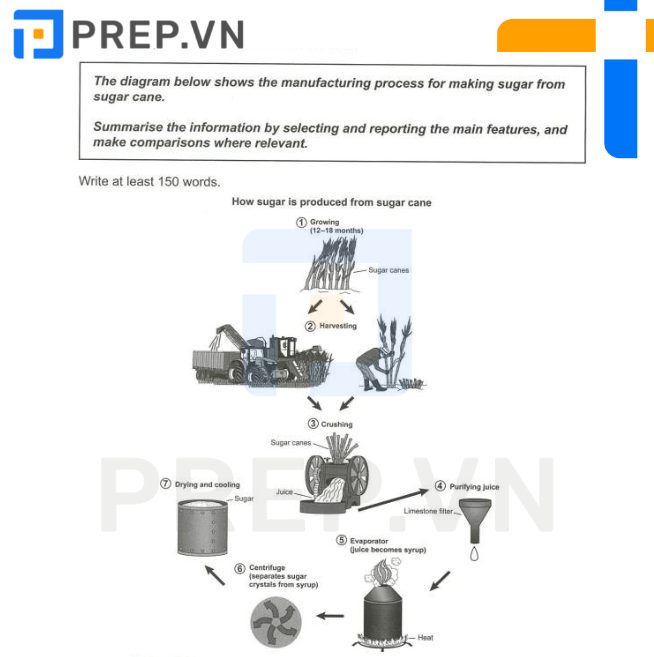
Bài mẫu đề thi IELTS Writing Task 1 Process - Sugar Cane:
The diagram gives insight into how sugar is made from sugar cane. Evidently, this isalengthy process, beginning with the cultivation of sugar canes and concluding with the end product being produced.
Initially, sugar canes are grown on fields for anywhere between 12 and 18 months, until they are ready to be harvested, either by hand or by the harvester. Then, they proceed to be squeezed inacrushing machine to produce sugar cane juice, which is led intoalimestone filter in turn. The step of running sugar cane juice throughalimestone filter ensures that the juice is purified, and that any residue is left behind.
Following filtration, the juice is heated inside an evaporator to condense it intoasyrupy substance. Once evaporation is complete, the separation of sugar crystals from the syrup will take place as the liquid is spun inacentrifuge. The result of this step, sugar crystals, is dried and cooled to await future possible steps.
8. Đề bài IELTS Writing Task 1 Process: Neuron thần kinh
Đề bài: “The diagram shows the components of a neuron and how it works. Summarize the information by selecting and reporting the main features, and make comparisons where relevant”.
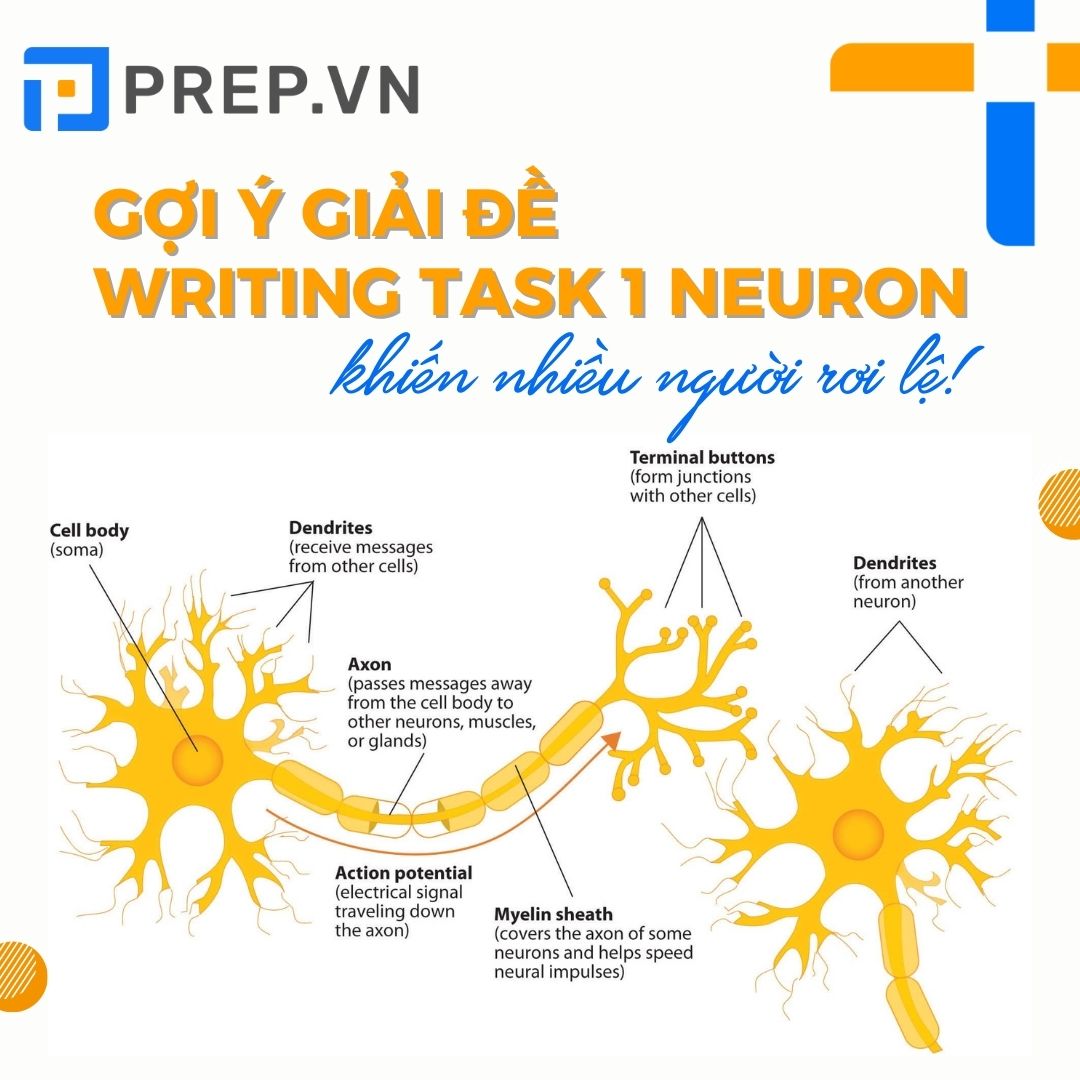
Bài mẫu đề thi IELTS Writing Task 1 Process - Neuron thần kinh:
XEM BÀI MẪU IELTS WRITING TASK 1 - NEURON THẦN KINH TẠI ĐÂY
9. Đề bài IELTS Writing Task 1 Diagram: LED flashlight works
Đề bài: "The diagram shows how an LED (light emitting diode) flashlight works. Summarise the information by selecting and reporting the main features, and make comparisons where relevant".
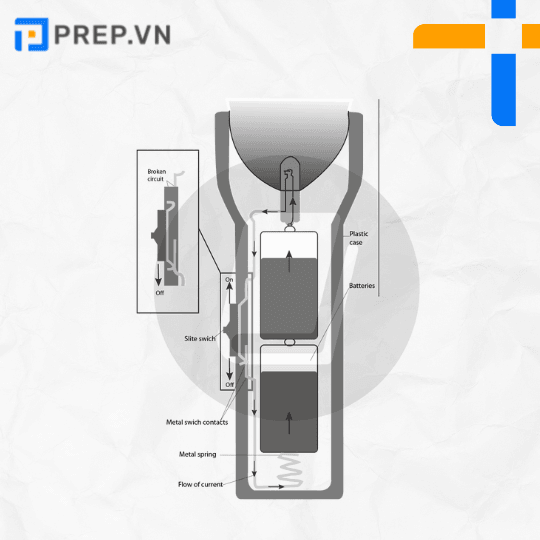
Bài mẫu đề thi IELTS Writing Task 1 Process/ Diagram - LED flashlight works:
The diagram displays the detailed cross-section of a light emitting diode flashlight. From the illustration, it can be inferred that the device makes use of an electrical circuit, with the batteries and the switch as its variable components.
At the bottom of the light is a metal spring, whose top end is connected to the anode of the batteries. The batteries’ cathode, meanwhile, makes contact with the light bulb to form one half of the circuit. To complete the circuit’s other half, a switch is placed on the flashlight’s handle, and linked with both the light bulb and the spring by electrical wiring. Outwardly, the device is covered by a plastic case for insulation.
Only when the switch is on and the batteries are inserted properly does the flashlight produce illumination. As electricity enters the negative pole and exits the positive, batteries have to be placed so that the cathode faces the light bulb and the anode touches the spring. To turn off the device, the user slides the switch away from the LED, which severs the connection between the switch’s metal contacts and the light.
- Cross-section (n.): mặt cắt
- Infer (v.): suy luận
- Circuit (n.): mạch
- Variable (adj.): có thể thay đổi
- Anode (n.): cực âm của pin
- Cathode (n.): cực dương của pin
- Handle (n.): tay nắm
- Electrical wiring (n.): dây điện
- Insulation (n.): cách điện
- Insert (v.): bỏ/đút vào
- Illumination (n.): ánh sáng
- Sever (v.): ngắt
II. Hướng dẫn luyện đề IELTS Writing Task 1 Process
Đối với IELTS Writing Task 1, đặc biệt là IELTS Writing Task 1 Process bạn nên chia ra 3 giai đoạn để luyện thi IELTS như sau:
1. Giai đoạn 1: Củng cố từ vựng
Để có thể làm tốt IELTS Writing, đặc biệt là đề IELTS Writing Task 1, thì bạn phải nắm chắc vốn từ vựng về xu hướng, biểu đồ,.... Do đó, dành thời gian để trau dồi lại vốn từ vựng là vô cùng cần thiết. Bỏ ra 2-3 tuần hoặc thậm chí là 1 tháng học từ vựng để áp dụng vào đề IELTS Writing Part 1 nhé. Hãy học từ vựng theo chủ đề để có thể vận dụng một cách hữu ích nhất. Tham khảo các từ vựng theo chủ đề tại:
2. Giai đoạn 2: Học theo dạng bài
Đề IELTS Writing Part 1 gồm 7 dạng chính:
- IELTS Writing Task 1 Line Graph
- IELTS Writing Task 1 Bar Chart
- IELTS Writing Task 1 Pie Chart
- IELTS Writing Task 1 Table
- IELTS Writing Task 1 Mixed
- IELTS Writing Task 1 Process
- IELTS Writing Task 1 Map
Do đó, với mỗi dạng bài bạn nên dành thời gian để luyện tập viết các phần: mở bài, tổng quan và thân bài. Dành thời gian khoảng 1 tuần cho từng dạng bài dễ như Line, Bar, Pie và Table, Mixed. Riêng những dạng khó đề IELTS Writing Task 1 Process và Map hãy tăng thời gian luyện tập lên đến 2 tuần.
- Bước 1: Tìm hiểu cách làm chung. Tập phân tích từng biểu đồ.
- Bước 2: Học các từ vựng chỉ xu hướng. Tập viết phần Introduction cho đề IELTS Writing Task 1. Lên dàn ý cho phần thân bài.
3. Giai đoạn 3: Luyện đề thi
Sau khi bạn đã luyện tập thành thục giai đoạn 1 và giai đoạn 2, thì hãy sẵn sàng thực hiện giai đoạn 3 - giai đoạn quan trọng nhất. Bước sang giai đoạn 3 khi bạn đã tích lũy được rất nhiều từ vựng và cấu trúc ngữ pháp giúp nắm chắc band điểm cao. Trong quá trình luyện đề thi, bạn hãy chú trọng luyện tập paraphrase, củng cố thêm collocation để chinh phục band điểm cao hơn.
Quá trình luyện tập diễn ra như sau: Đầu tiên bạn hãy viết nháp bài thi, sau đó đọc các ví dụ và sửa lại. Khi đó bạn sẽ học thêm được từ mới, collocation và paraphrase. Hãy phân bổ thời gian thật hợp lý để luyện tập bạn nhé.
Tham khảo thêm bài viết:
III. Lời Kết
Giờ đây bạn còn thấy đề IELTS Writing Task 1 PROCESS còn khó nhằn nữa không nào. Luyện tập chăm chỉ thì chẳng còn sợ những đề thi hóc búa nữa. Chờ đợi những bài mẫu IELTS Writing Task 1 PROCESS đặc biệt được thầy cô PREP biên soạn bạn nhé. Chúc bạn một ngày học tập thật hiệu quả!

Bình luận
Tìm kiếm bài viết học tập
Có thể bạn quan tâm

Aptis FTU: Tổ chức thi Aptis tại Đại học Ngoại thương

Những thông tin cần biết về chứng minh tài chính du học Tây Ban Nha mới nhất

Cẩm nang chứng minh tài chính du học Pháp mới nhất

Chứng minh tài chính du học như thế nào? Có thể du học mà không cần chứng minh tài chính?

Du học Cuba: điều kiện, chi phí, học bổng mới nhất
Đăng ký tư vấn lộ trình học
Bạn hãy để lại thông tin, Prep sẽ liên hệ tư vấn cho mình ngay nha!





